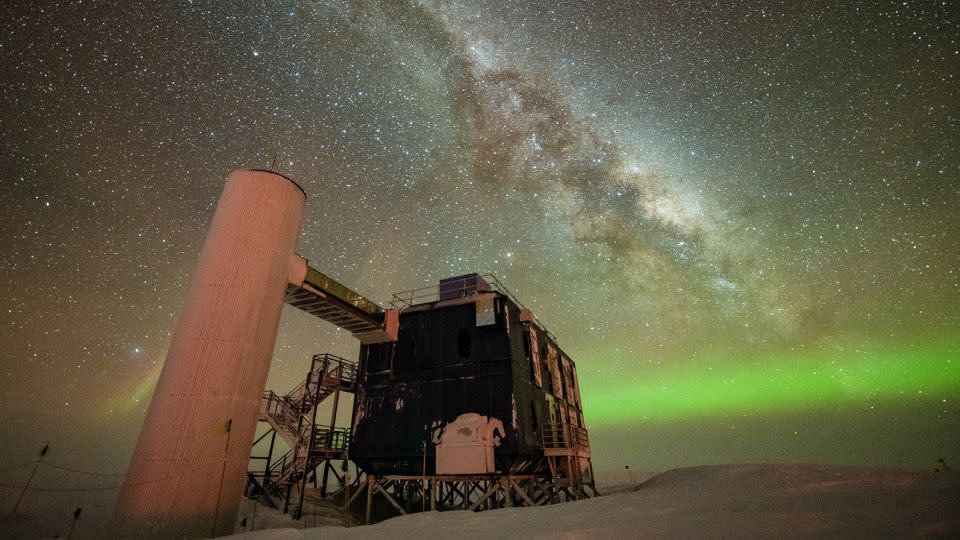An observatory in Antarctica reveals ‘ghostly’ new portrait of the Milky Way
Editor’s Note: Sign up for CNN’s Wonder Theory science newsletter. Explore the universe with news on fascinating discoveries, scientific advancements and more.
For the first time, astronomers have assembled a glowing portrait of the Milky Way galaxy using cosmic “ghost particles” detected by a telescope embedded in Antarctica’s ice.
Over the years, astronomers have showcased stunning images of the Milky Way through electromagnetic radiation from visible light or radio waves. But this is a new perspective of our galaxy based on particles of matter, rather than energy.
The so-called ghost particles are neutrinos. These tiny, high-energy cosmic particles are often referred to as ghostly because they are extremely vaporous and can pass through any kind of matter without changing.
The research was published Thursday in the journal Science.
“I remember saying, ‘At this point in human history, we’re the first ones to see our galaxy in anything other than light,’” said study coauthor Naoko Kurahashi Neilson, associate professor of physics at Drexel University, in a statement reflecting on when she and two doctoral students initially saw the image.
Neutrinos have almost no mass and can travel through the most extreme environments — including stars, planets and entire galaxies — and not change their structure at all. It’s likely that billions of them pass through us each day, and we just don’t feel them.
Ghost particles are difficult to detect because they don’t often interact with their surroundings, but they do interact with ice. And the highest concentration of ice on Earth can be found in Antarctica.
An international team of scientists used the IceCube Neutrino Observatory at the National Science Foundation’s Amundsen–Scott South Pole Station in Antarctica to detect neutrinos and trace them back to their origins.
An icy way to study the cosmos
The IceCube detector, which became operational in 2010, is the largest of its kind. The observatory can monitor 1 billion tons of the Antarctic ice for neutrino interactions. To build the detector, workers drilled 86 holes in the ice, each 1.5 miles (2.4 kilometers) deep, and spread a network of 5,160 light sensors over a grid that spans 0.2 cubic mile (1 cubic kilometer).
As neutrinos interact with the ice, they create faint light patterns that IceCube detects. Some of the light patterns point to specific regions of the sky, which allows astronomers to trace where they originated. In one 2018 case, scientists were able to use IceCube to trace the origins of a neutrino that traveled 3.7 billion light-years to Earth.
But other interactions between neutrinos and ice just produce “fuzz balls of light,” which makes tracing their path to Earth much more difficult, said Kurahashi Neilson.

Together, she and doctoral students Steve Sclafani at Drexel University and Mirco Hünnefeld at Germany’s TU Dortmund University created a machine-learning algorithm to compare the size, energy and relative position of more than 60,000 neutrino light patterns detected by IceCube over 10 years.
The trio spent more than two years testing the algorithm before providing it with IceCube data. The end result was an image showing bright points of light across the Milky Way that are likely to emit neutrinos, creating a new portrait of our galaxy.
“Seeing our galaxy with neutrinos is something that we dreamed of, but which seemed out of reach for our project for many years to come,” said study coauthor Chad Finley, associate professor of physics at Stockholm University and IceCube team member, in a statement. “What made this result possible today is the revolution in Machine Learning, allowing us to explore much deeper into our data than before.”
Some of the locations pinpointed in the image are also the site of previously observed gamma rays created when cosmic rays collided with galactic gas and dust. Such interactions are also thought to create neutrinos, but defining specific sources of neutrinos is a key goal for researchers going forward.
“A neutrino counterpart has now been measured, thus confirming what we know about our galaxy and cosmic ray sources,” Sclafani said.
Chasing cosmic mysteries
Researchers now believe after seeing the image that cosmic ray interactions are more intense in the galactic center.
Cosmic rays, the most highly energetic particles in the universe, bombard Earth from space with radiation. These ionizing particles in our atmosphere were detected for the first time more than 100 years ago, in 1912, by physicist Victor Hess. He determined that they came from space.
Cosmic rays are mostly made up of protons or atomic nuclei that have been stripped from atoms, according to NASA.
But these rays have puzzled scientists ever since their discovery. Where do they come from, and what creates and launches them across the universe? Neutrinos could tell us.
Now, the team wants to investigate specific sources of neutrinos across the galaxy.
“Observing our own galaxy for the first time using particles instead of light is a huge step,” Kurahashi Neilson said.
“As neutrino astronomy evolves, we will get a new lens with which to observe the universe. This is why we do what we do. To see something nobody has ever seen, and to understand things we haven’t understood.”
For more CNN news and newsletters create an account at CNN.com

